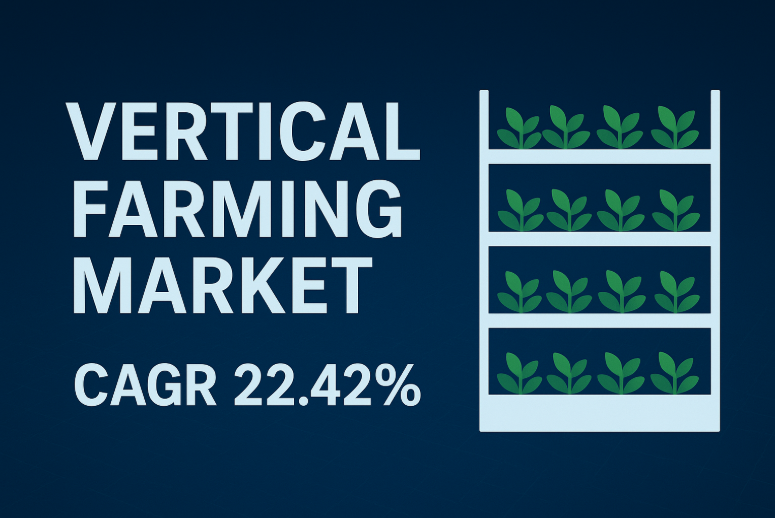The Vertical Farming Market is emerging as a transformative trend in modern agriculture, offering a sustainable solution to feed the rapidly growing global population. With the world facing challenges like urbanization, climate change, and limited arable land, vertical farming presents an innovative method to grow crops efficiently in controlled environments. This market is witnessing significant interest from investors, technology providers, and urban planners due to its potential to ensure year-round production, reduce resource consumption, and minimize transportation costs.
Vertical Farming Market Size and Growth
The Vertical Farming Market Size was valued at USD 7.11 Billion in 2024. It is estimated to reach USD 35.88 Billion by 2032, growing at a CAGR of 22.42% during 2025-2032. This rapid growth is driven by the increasing adoption of automated farming solutions, advancements in hydroponics, aeroponics, and aquaponics systems, and the rising demand for fresh, locally grown produce. As awareness about food security and sustainability intensifies, vertical farming is becoming a preferred choice for both commercial growers and urban communities seeking efficient agricultural practices.
Request Free Sample Report @ https://www.snsinsider.com/sample-request/2897
Key Drivers in the Vertical Farming Market
The expansion of the Vertical Farming Market is fueled by several critical factors. First, urbanization and population growth are straining traditional farming methods, creating a need for innovative, space-efficient solutions. Second, advancements in technology, including IoT sensors, AI-based crop monitoring, and automated nutrient delivery systems, have enhanced productivity and reduced operational costs. Third, government initiatives and incentives promoting sustainable agriculture and smart city projects are accelerating market adoption globally. These drivers collectively underscore the vertical farming model as a viable alternative to conventional agriculture.
Challenges Facing the Vertical Farming Market
Despite its promising growth, the Vertical Farming Market faces several challenges. High initial investment costs for infrastructure and technology remain a barrier for small-scale adopters. Additionally, the requirement for skilled labor to manage sophisticated systems can hinder rapid implementation. Energy consumption, particularly for lighting and climate control, is another concern, although renewable energy integration is helping mitigate this issue. Addressing these challenges will be crucial for market stakeholders to ensure sustainable expansion.
Opportunities in the Vertical Farming Market
The Vertical Farming Market offers numerous opportunities for growth and innovation. Companies can leverage automation and AI to optimize resource usage and increase crop yields. Expanding into untapped regions, especially in Asia-Pacific and Africa, where urbanization is accelerating, can provide significant growth potential. Moreover, collaborations with tech firms and research institutions can facilitate the development of energy-efficient systems and innovative cultivation techniques, enhancing profitability and sustainability. The growing consumer preference for organic and locally sourced produce also opens new avenues for market participants.
Regional Insights in the Vertical Farming Market
Geographically, the Vertical Farming Market is experiencing diverse growth patterns. North America and Europe are leading due to technological advancement, strong investment in smart agriculture, and consumer demand for fresh produce. Asia-Pacific is emerging as a high-growth region, driven by rapid urbanization, increasing disposable income, and government initiatives supporting modern farming practices. Latin America and the Middle East & Africa are also showing potential, with urban agriculture gaining traction to improve food security and reduce reliance on imports.
Vertical Farming Market Trends and Future Outlook
The Vertical Farming Market is poised for continued growth as technological innovations and sustainability initiatives advance. Trends such as vertical integration, energy-efficient LED lighting, and the use of renewable energy sources are reshaping the market landscape. Future prospects include the development of fully automated vertical farms and integration with smart city infrastructure, enabling urban centers to achieve self-sufficiency in food production. As consumer awareness and investment in sustainable agriculture grow, the vertical farming model is set to become a mainstream solution globally.
FAQs about Vertical Farming Market
Q1: What is the expected CAGR of the Vertical Farming Market during 2025-2032?
A1: The Vertical Farming Market is projected to grow at a CAGR of 22.42% during the forecast period 2025-2032, reflecting strong adoption of innovative farming technologies and increasing demand for sustainable agriculture solutions.
Q2: How is the Vertical Farming Market expected to evolve by 2032?
A2: The Vertical Farming Market is estimated to reach USD 35.88 Billion by 2032, driven by advancements in hydroponics, aeroponics, and AI-driven farming systems, alongside the rising consumer preference for fresh, locally produced food.
Q3: Which regions are expected to lead the Vertical Farming Market growth?
A3: North America and Europe are currently leading the market due to technological advancements and investment in smart agriculture. Asia-Pacific is the fastest-growing region, fueled by urbanization, government initiatives, and increasing disposable income, creating substantial opportunities for vertical farming adoption.

